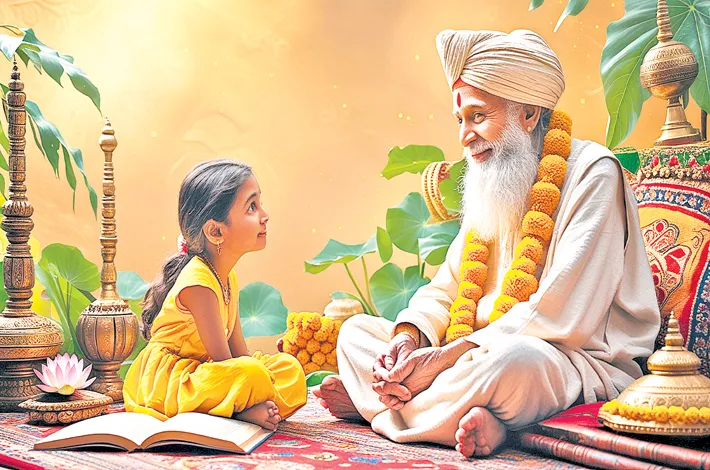The Ideal Relationship Between Teachers & Students
20-03-2025 12:00:00 AM

The ideal relationship between teachers and students, as envisioned by Indian ethos, is a sacred partnership rooted in trust, respect, and mutual growth. The guru ignites the spark of knowledge and virtue, while the shishya fuels it with dedication and inquiry
In the rich tapestry of Indian culture, the relationship between teachers and students has long been regarded as sacred, a bond that transcends mere knowledge transfer and delves into the realms of personal growth, moral development, and spiritual awakening. Rooted in ancient traditions, texts like the Upanishads, Guru Granth Sahib, and the teachings of luminaries such as Swami Vivekananda and Rabindranath Tagore, the Indian ethos envisions this relationship as a dynamic interplay of respect, trust, guidance, and mutual evolution. The ideal teacher-student relationship, or Guru-Shishya parampara, is not just an educational framework but a holistic philosophy that nurtures the mind, body, and soul.
The Guru: A Beacon of Wisdom and Compassion
In Indian tradition, the term "guru" is derived from two Sanskrit syllables: gu (darkness) and ru (remover), symbolizing one who dispels ignorance and illuminates the path to enlightenment. The guru is not merely an instructor but a mentor, a guide, and, in many cases, a parental figure.
This reverence is beautifully captured in the ancient saying, "Guru Devo Bhava" — the guru is akin to a divine entity. However, this elevated status comes with immense responsibility. The ideal guru embodies humility, patience, and compassion, tailoring their teachings to the unique needs of each student.
The Indian ethos emphasizes that a teacher’s role extends beyond academics. They are tasked with instilling dharma (righteousness), satyam (truth), and ahimsa (non-violence) in their students. For instance, in the Taittiriya Upanishad, a teacher advises the student departing from the gurukul: “Speak the truth, practice righteousness, do not neglect self-study.” This reflects the guru’s duty to shape character and foster a lifelong pursuit of knowledge.
The Shishya: A Seeker of Knowledge and Virtue
The student, or shishya, is not a passive recipient but an active participant in this relationship. The Indian ethos expects the shishya to approach learning with shraddha (faith), vinaya (humility), and seva (service). Respect for the guru is paramount, as seen in tales like that of Arjuna and Dronacharya from the Mahabharata, where devotion and discipline elevate the student’s potential. Yet, this respect is not blind obedience; it is a mutual trust that allows the shishya to question, explore, and grow.
The shishya’s role is to internalize the guru’s teachings and apply them in life. The Indian tradition values experiential learning, where knowledge (jnana) is not hoarded but lived. This is evident in the gurukul system, where students resided with their teachers, engaging in daily chores alongside intellectual pursuits, fostering a holistic education that blended theory with practice.
Mutual Growth: A Symbiotic Bond
The essence of the ideal teacher-student relationship in Indian ethos lies in its reciprocity. While the guru imparts wisdom, the shishya’s curiosity and progress enrich the guru’s purpose. This is beautifully articulated by Swami Vivekananda, who said, “The true teacher is he who can immediately come down to the level of the student, and transfer his soul to the student’s soul and see through the student’s eyes.” This empathetic connection ensures that learning is not a one-way street but a shared journey.
Tagore’s educational philosophy, as practiced in Shantiniketan, further exemplifies this symbiosis. He envisioned teachers and students learning together in nature’s embrace, free from rigid hierarchies. This egalitarian approach aligns with the Indian belief that true education liberates both the teacher and the taught, fostering creativity and self-realization.
Discipline and Freedom: A Balanced Approach
Indian ethos strikes a delicate balance between discipline and freedom in the teacher-student dynamic. The guru provides structure through sadhana (consistent effort) and tapas (self-discipline), yet encourages the shishya to question and seek answers independently. The story of Nachiketa in the Kathopanishad, who boldly questions Yama, the god of death, about the nature of the soul, illustrates this freedom. His guru, Yama, respects his inquiry and rewards his persistence with profound wisdom.
This balance ensures that students are neither spoon-fed nor left adrift. The teacher’s authority is tempered by love, and the student’s autonomy is guided by responsibility. Such an approach cultivates critical thinking, resilience, and a sense of purpose.
Relevance in the Modern Context
In today’s fast-paced, technology-driven world, the Indian ethos of the teacher-student relationship remains profoundly relevant. While classrooms have evolved into digital spaces, the principles of mutual respect, holistic development, and moral grounding are timeless. Modern educators can draw from this tradition to foster environments where students are not just prepared for exams but for life. The guru’s role as a mentor can counter the alienation of virtual learning, while the shishya’s humility can temper the distractions of the digital age.
Moreover, the Indian emphasis on character-building addresses contemporary challenges like ethical dilemmas and mental health. By integrating values like empathy and mindfulness—hallmarks of the Guru-Shishya parampara—teachers can nurture students who are not only skilled but also compassionate global citizens.
Conclusion
The ideal relationship between teachers and students, as envisioned by Indian ethos, is a sacred partnership rooted in trust, respect, and mutual growth. The guru ignites the spark of knowledge and virtue, while the shishya fuels it with dedication and inquiry.
Together, they weave a legacy of learning that transcends generations. In an era of rapid change, this timeless bond reminds us that education is not just about acquiring information but about awakening the human spirit—a philosophy that continues to inspire and guide humanity toward a higher purpose.
The Ideal Relationship Between Teachers and Students: An Indian Ethos Perspective
In the rich tapestry of Indian culture, the relationship between teachers and students has long been regarded as sacred, a bond that transcends mere knowledge transfer and delves into the realms of personal growth, moral development, and spiritual awakening.
Rooted in ancient traditions, texts like the Upanishads, Guru Granth Sahib, and the teachings of luminaries such as Swami Vivekananda and Rabindranath Tagore, the Indian ethos envisions this relationship as a dynamic interplay of respect, trust, guidance, and mutual evolution. The ideal teacher-student relationship, or Guru-Shishya parampara, is not just an educational framework but a holistic philosophy that nurtures the mind, body, and soul.








